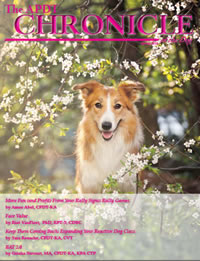One of the most important aspects of a humane training protocol is that it is minimally intrusive. One way to think of minimally intrusive is that the animal has maximal control over significant events. BAT 2.0 shifts forward to focus even more on allowing the dog to have control of the process within a safe setting. As Dr. Susan Friedman wrote, “The degree to which a behavior reduction procedure preserves learner control is essential to developing a standard of humane, effective practice.”
Here’s an example of a video by Canadian dog trainer Jennie Murphy, CBATI, CGN, DN-FSG that demonstrates a change in BAT from 1.0 to 2.0: we make sure to let the dog choose where to go, as long as that movement wouldn’t put the dog in too stressful of a place.
My first book, Behavior Adjustment Training, came out in 2010. My third book, BAT 2.0 came out in 2016. I developed BAT primarily for the rehabilitation of reactivity with dogs caused by fear, frustration, or anger. In the first book and in my videos, handlers were taught to observe and mark certain behavior and/or body language and to reinforce that behavior by moving away from the Scary Monster and (sometimes) add “bonus rewards” of food, toys, etc.
While the core philosophy of BAT is still the same, BAT is no longer primarily a procedure in which the trainer marks and reinforces social behavior. BAT is now more naturalistic and the trainer’s main task is to arrange the situation to let the dog learn in a way that is similar to how well socialized dogs learned about other dogs, people, and other stimuli as puppies.
We do have a BAT 2.0 procedure called Mark and Move that reinforces social behavior with distance plus tangible reinforcers in certain situations, so some parts of it look a little bit like BAT 1.0. However, and this is important, even with Mark and Move, we do not lead the dog directly toward the trigger as we did in BAT 1.0.
In the first book, I mentioned that BAT is, and will always be, a work in progress, based on the best information available at the time. I have fine-tuned BAT over the years and I have decided that it’s time to officially announce some changes that simplify the process and make it even less stressful and more pleasant for the dogs.
Please click here to get started learning about BAT 2.0, or look for one of our upcoming seminars or online learning opportunities.
NOTE: All articles published before January 2014 are about the older (1.0) version of BAT.
Three main aspects of the original BAT still form the foundation of the new BAT:
- Give the dog control over their exposure to the trigger
- Continually assess stress and strive to reduce it
- Use management tools to lower stress outside of training to reduce setbacks
Here are some of the differences:
| BAT 2.0 |
BAT in 2010 (DVD & Book) |
- Naturally occurring reinforcers (antecedent arrangements, most reinforcers are naturally occurring, focus on respondent learning)
- Very dog-centered (follow the dog)
- Controllability due to interaction with trigger and movement in space
- Specific leash skills to keep handler out of the way
- Simpler: No stages, just a flow of how much we need to prompt
|
- Reinforcement provided by trainer (theorized walking away as R-)
- Moderately dog-centered (still followed the dog, but did more encouragement to approach)
- Controllability due to trainer marking and theoretically reinforcing behavior
- Minimal focus on handler leash skills
- Specific Stages 1, 2, and 3, which took time to explain & learn
|
Here’s another video example, by Dutch trainer Liselot Boersma, PgDip CABW:
Please click here to get started learning about BAT 2.0, or look for one of our upcoming seminars or online learning opportunities (Books, streaming videos, DVDs, online courses, etc).
 Learn about BAT 2.0 in the Spring 2014 issue of the APDT Chronicle of the Dog and in the popular UK Magazine, Dogs Today. Check them out!
Learn about BAT 2.0 in the Spring 2014 issue of the APDT Chronicle of the Dog and in the popular UK Magazine, Dogs Today. Check them out!

 Many dogs do not come to us as clean slates. They have already gone through a variety of other training techniques from the owners and potentially other trainers. It is helpful to know exactly how the other techniques are done so that we can help our clients decide what is best for their dogs.
Many dogs do not come to us as clean slates. They have already gone through a variety of other training techniques from the owners and potentially other trainers. It is helpful to know exactly how the other techniques are done so that we can help our clients decide what is best for their dogs.